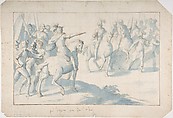Mounted Warrior with a Baton Giving Orders to His Troops
Belisario Corenzio Italian, born Greece
Not on view
The present drawing and a second one in the Museum's collection (acc. no. 68.203) were part of a group of eleven sold with an attribution to Belisario Corenzio in London in 1936. At that time, the whole series was purchased by Sir Robert Witt (1872-1952) who, after later dispersals of his collection, retained only three drawings, now in the Witt Collection at the Courtauld Institute Galleries, London (nos. 2789A, 2789B, 2789C.)
After the Witt sale, of the remaining eight, two drawings found their way to the Metropolitan Museum of Art (nos. 68.203 and 66.127), one is in the National Gallery of Art, Washington, D.C. (inv. 2010.93.17, formerly in the collection of Joseph McCrindle, New York; and The Sir Anthony Blunt Collection, exhibition catalogue, Courtauld Institute Galleries, London, 1964, no. 8), three were recorded in 1992 in a private collection in Paris, while the present whereabouts of two remains unknown.
All the drawings measure approximately the same size (circa 21.5 x 33.5 cm), and are characterized by a delicate use of transparent blue wash contrasting with a rather fine brown pen line. The traditional attribution to Corenzio was supported by Walter Vitzthum, who thought it plausible that the subject might relate to a narrative cycle devoted to Don Juan de Austria, natural son of Charles V, captain general of the allied fleet that defeated the Turks at Lepanto and resident of Naples from 1573 to 1576. Vitzthum dated this narrative series early in Corenzio's career, when Tuscan influences were paramount in his draftsmanship. Similarities of style and subject matter led Vitzthum to associate two further drawings with the Don Juan de Austria series: ‘Moors or Turks Paying Homage to a Victorious General’ in the Cooper-Hewitt Museum (no. 1938-88-7080), and a more general ‘Battle Scene’ in the Biblioteca Nacional, Madrid (A. M. de Barcia, Catálogo de la colección de dibujos originales de la Biblioteca Nacional, Madrid, 1906, no. 8105, as anonymous Italian).
In 1982 Silvia Musella Guida attributed the Courtuauld drawing, featuring a scene with the 'Triumphal entrance in Naples of Don Juan de Austria', to the Tuscan-born Giovanni Balducci, known as 'il Cosci' (Florence 1560 - after 1631 Naples), an artist who spent his youth in Florence, as a follower of Giovanni Battista Naldini and Federico Zuccari, and eventually moved to Naples by the end of the sixteenth century. The name of Balducci was endorsed by Mario Di Giampaolo who, in 1992, extended the new attributuion the whole series, including the two sheets in the Metropolitan Museum of Art (see here bibliography and Di Giampaolo 1992 and 2010) and the one now in Washington. On the contrary, Giulia Fusconi has retained the traditional attribution to Corenzio by comparing the two Metropolitan sheets to Corenzio’s drawings now in Turin (Biblioteca Reale, inv. 16212) and Hartford (Wadsworth Atheneum, inv. 15611). While it is the opinion of the curators of The Metropolitan Museum of Art that these drawings are by Corenzio, it is indubitable that they reveal elements of style that are indebted to Tuscan draftsmanship.
(Furio Rinaldi, 2014)
Due to rights restrictions, this image cannot be enlarged, viewed at full screen, or downloaded.
This artwork is meant to be viewed from right to left. Scroll left to view more.






